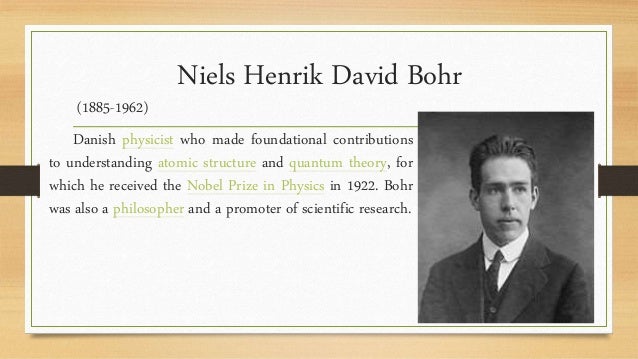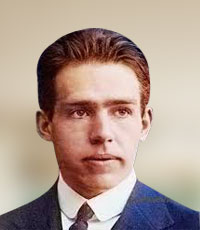Niels Bohr, in full Niels Henrik David Bohr, (born October 7, 1885, Copenhagen, Denmark—died November 18, 1962, Copenhagen), Danish physicist who is generally regarded as one of.
- Niels Bohr Model
- Neil Bohr's Model
- Niels Bohr Atom Theory
- Neil Bohr Atomic Model
- Neil Bohr's Model
- Niels Bohr Discovery
- Neil Bohr's
- Niels Bohr investigated the structure of the atom and won the Nobel Prize in Physics in 1922 for discovering the Bohr model. He developed the liquid drop model of the atomic nucleus, proposed the idea of complementarity and identified the U-235 isotope essential for nuclear fission.
- Niels Bohr, there is often some confusion concerning both what the Copenhagen interpretation precisely amounts to, and which parts of this interpretation are associated with whom of the founding figures of quantum mechanics. But there are signs that the mist is beginning to clear up. For instance, Howard (2004) convincingly argues that.

AKA Niels Henrik David Bohr
Born:7-Oct-1885
Birthplace:Copenhagen, Denmark
Died:18-Nov-1962
Location of death:Copenhagen, Denmark
Cause of death:Stroke
Remains: Buried, Assistens Cemetery, Copenhagen, Denmark
Gender: Male
Religion:Lutheran
Race or Ethnicity: White
Sexual orientation: Straight
Occupation:Physicist


Nationality: Denmark
Executive summary: Father of Quantum Theory
Danish physicist Niels Bohr studied under J. J. Thomson, who discouraged his ideas, and under Ernest Rutherford, whose work was expanded by Bohr into a new theory on the structure of the atom in 1913. Bohr postulated that electrons travel in fixed orbits around the atom's nucleus, and further explained how electrons emit or absorb energy, work that earned him the Nobel Prize in Physics in 1922. Bohr's atomic diagram held that the outer orbits hold more electrons than inner orbits, that atoms traveling from one orbit to another emit tiny amounts of radiation, and that these orbits determine chemical properties of an atom.

Bohr's theory, elaborated and expanded by other physicists, formed the basis for the developing science of quantum mechanics. He is best known for two concepts — the correspondence principle, and the complementarity principle. The former holds that to untangle the contradictions between 'old' and 'new' physics, new theories must both describe atomic phenomena correctly and be applicable to conventional phenomena; the latter holds that wave and particle aspects of nature are complementary and can never both be true simultaneously.
Niels Bohr Model
Though raised and baptized a Christian, his mother was Jewish, and Bohr fled Denmark during World War II, coming to America, where he worked on the Manhattan Project. After the war he became an outspoken activist against nuclear weapons and for the peaceful use of atomic energy. He was also a co-founder of the European Organization for Nuclear Research (CERN).

Bohr's brother, mathematician Harald August Bohr (1887-1951), developed a theory of 'almost periodic' functions, and won a Silver Medal playing soccer for the Danish national team in the 1908 Olympics. Niels Bohr's son, Aage N. Bohr, won the Nobel Prize in Physics in 1975 for describing the collective model of the atomic nucleus.
Father: Christian Bohr (lecturer in physiology)
Mother: Ellen Adler Bohr (b. 7-Oct-1860, m. 1881)
Sister: Jennifer ('Jenny', b. 1883)
Brother: Harald August Bohr (mathematician, b. 1887, d. 22-Jan-1951)
Wife: Margrethe Norlund (m. 1-Aug-1912, six sons)
Son:Aage N. Bohr (physicist and Nobel Laureate, b. 19-Jun-1922, d. 8-Sep-2009)
Son: Erik Bohr (chemist)
Son: Ernest Bohr (attorney)
Son: Hans Henrik Bohr (physician)
High School: Gammelholm Grammar School, Copenhagen (1903)
University: MA Physics, University of Copenhagen (1909)
University: PhD Physics, University of Copenhagen (1911)
Lecturer: Physics, University of Copenhagen (1913-14)
Lecturer: Physics, Victoria University of Manchester (1914-16)
Professor: Theoretical Physics, University of Copenhagen (1916-62)
Administrator: Institute of Theoretical Physics, University of Copenhagen (1920-62)
Nobel Prize for Physics 1922
Hughes Medal 1921
Matteucci Medal 1923
Copley Medal 1938
United States Atoms for Peace Award 1957
Sonning Prize 1961
American Academy of Arts and Sciences Foreign Honorary Member
American Philosophical Society 1940
CERN Co-Founder (1954)
Pontifical Academy of Sciences
Royal Danish Academy of Sciences 1917
Royal Danish Academy of Sciences President (1938-62)
Royal Institution of Great Britain (Foreign Member)
Royal Society 1926 (Foreign Member)
Royal Society of Edinburgh 1927 (Foreign Member)
Manhattan Project
Stroke
Chemical Element Namesake bohrium (Bh, 107)
Lunar Crater Bohr (12.8°N 86.4°W, 71 km. diameter)
Asteroid Namesake 3948 Bohr
Danish Ancestry Paternal
Jewish Ancestry Maternal
Neil Bohr's Model
Author of books:
The Philosophical Writings of Niels Bohr (1987, essays; three volumes)
Niels Bohr: Collected Works (2008, thirteen volumes)
Niels Bohr Atom Theory
| New! NNDB MAPPER | Create a map starting with | Niels Bohr |
Neil Bohr Atomic Model
Requires Flash 7+ and Javascript.Neil Bohr's Model
Do you know something we don't?
Submit a correction or make a comment about this profile
Niels Bohr Discovery
Neil Bohr's
Copyright ©2019 Soylent Communications
